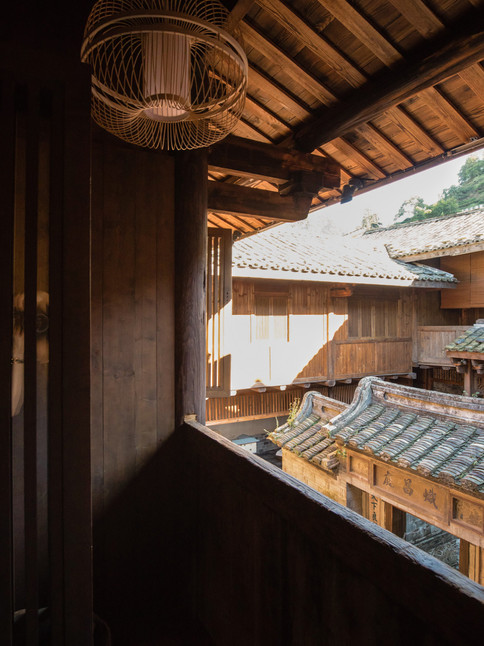TSINGPU TULOU RETREAT
- mastic lifestyle

- May 4, 2022
- 4 min read
Updated: Jun 22, 2023
In the Fujian region of southeastern China, the Trace Architecture Office firm has created a luxurious retreat where tradition and modernity blend in perfect harmony. In the middle of mountains of pines and bamboos, the hotel plunges us into a historical Chinese aesthetic worthy of the film Raise the Red Lantern while offering a contemporary luxury service. A decorative concept that applies yin and yang as a whole.

The Fujian region, a UNESCO World Heritage Site, is a well-kept secret. Its geological, architectural and cultural heritage amaze lovers of nature and authenticity. It is in this landscape of steep mountains and lush vegetation that the investor Wang Gongquan asked Trace Architecture Office to design in the village of Taxia, a luxury retreat based on the foundations of a set of buildings traditional Tulous dating in part from the Qing dynasty. These constructions typical of the Hakka people inhabiting the region constitute an exceptional model of architecture of which no less than forty-six sites are listed as World Heritage Sites. The Tulous, residences of the community type, were distinguished by their square or circular plan as well as by their large central mineral courtyard, a place of life shared by the occupants before joining their respective dwellings on the floors built of wood.

« The Tulous are examples of exceptional buildings in terms of their construction tradition and their function. They constitute a unique model of human settlement, based on community life and defensive needs while maintaining a harmonious relationship with their environment. ».

The restoration project scrupulously respects the architectural characteristics of Les Tulous. The new complex consists of three two-storey residential buildings, another smaller building and annexes covering a total of 3700 m2. The spaces have retained their former functions and are now gathered in a single structure characterized by the common areas on the ground floor and the bedrooms upstairs. The hotel focuses on the outdoor courtyard bordered by the river that crosses the hotel, and whose pebble and stone floors trace paths and define relaxation areas specific to Zen culture. This large courtyard gives access to the original three main buildings via ornate portals leading to the individual courtyards. The annex building was completely rebuilt and transformed into an open gallery separated from the courtyard by folding shutters.

The wish of the owner and the architects was to preserve the exceptional character of the building and to restore its splendor while providing it with modern functionality and comfort. Thus, the whole building is dressed in natural materials faithful to the original elements: natural stones, pebbles, terracotta, tiles and especially the ubiquitous wood used among other things for the construction of balconies, windows and shutters. . Some characteristic details of the Tulous have been reproduced where they had disappeared, notably the finely carved eaves decorations in the beams and columns. Also an architectural singularity signs the originality of the decoration; some interior and exterior walls are made up of a superposition of small curved tiles laid flat giving a unique lace effect. A superb architectural rendering which, without contrasting with the rest of the decor, underlines the quality and value of the project.

The refined and refined atmosphere of the Tsingpu Tulou Retreat invites us to reconsider the definition of luxury in an era where glitz prevails. Here, splendor is synonymous with respect for nature and traditions, and the decorative concept as well as its quality of execution lead to this reflection. The hotel perfectly illustrates the possibility of reconciling heritage and contemporary creation with its refined interior decoration which perfectly matches its more refined ancestral architecture. The modern lines of the tapered trellises and handcrafted furniture embrace the old structure, and the natural and vegetal hues inspired by the nearby forest dress the hotel in shades of wood enhanced with green. A Zen atmosphere conducive to contemplation inscribed in a soft setting.

"The refined and refined atmosphere of the Tsingpu Tulou invites us to reconsider the definition of luxury in an era where glitz prevails. Here, splendor is synonymous with respect for nature and traditions, and the decorative concept encourages this reflection.."

The restaurant is no exception to the concept of the hotel and offers authentic or revisited traditional Hakka cuisine. The tables open onto the outdoor spaces and the mountain, thus offering customers an additional sensory experience. Of course, tea is an integral part of the taste experience and even invites you to practice its ceremony..
The activities offered at Ginspu Tulou Retreat celebrate the Hakka region and culture. They praise simplicity and urge grounding and introspection. The historical context of the place is conducive to discovering the ancient secrets of Fengshui design, to learning about painting on wood or pottery workshops. Also, the unspoiled nature of the region invites you to hike in the mountains, to walk in the bamboo groves and to discover the neighboring villages. As a retreat, calm and relaxation are privileged here.
In my bag
Our "must-have" selection for a stay at Tsingpu Tulou Retreat.
Mary Jane olive, L'Espadrille de Venise
Pologne denim jacket, Soeur
Jordaan sunglasses, Mr Boho
Bamboo cleansing water, Orvéda
Raise the red lantern _ SuTong
Informations
Tsingpu Tulou Retreat
Taxia Village, Shuyang Town
Zhangzhou , Fujian Province
Fares
double room from 300,00€ per night
crédits photos © tsingpu tulou retreat






































